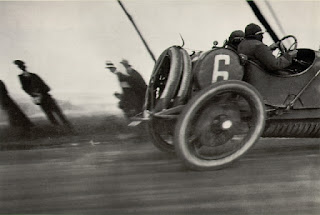PHOTOGRAPHY TO ME IS CATCHING A MOMENT WHICH IS PASSING,
AND WHICH IS TRUE.
AND WHICH IS TRUE.

Jacques Lartigue was born in Courbevoie on June 13, 1894. He took his first photographs at the age of six, using his father’s camera, and started keeping what would become a lifelong diary. In 1904 he began making photographs and drawings of family games and childhood experiences, also capturing the beginnings of aviation and cars and the smart women of the Bois de Boulogne as well as society and sporting events. An unfailingly curious amateur, he tried out all the available techniques, tirelessly recording the fleeting moments and meticulously arranging his several thousand images in large albums.

However, it would seem that photography was not his true vocation. In 1915 he attended the Académie Jullian: painting was to remain his professional activity and from 1922 onwards he exhibited in the salons of Paris and southern France. His acquaintances in the world of the arts included Sacha Guitry and Yvonne Printemps, Kees van Dongen, Pablo Picasso and Jean Cocteau, while his passion for movies saw him work as still photographer with Jacques Feyder, Abel Gance, Robert Bresson, François Truffaut and Federico Fellini.

Although Lartigue occasionally sold his pictures to the press and exhibited at the Galerie d’Orsay alongside Brassaï, Man Ray and Doisneau, his reputation as a photographer was not truly established until he was 69, with a retrospective at the Museum of Modern Art in New York and the publication of a portfolio in Life. He now added his father’s first name to his own surname, becoming Jacques Henri Lartigue. Worldwide fame came three years later with his first book, The Family Album, followed in 1970, by Diary of a Century, conceived by Richard Avedon. In 1975 he had his first French retrospective at the Musée des Arts Décoratifs in Paris. For the rest of his life, Lartigue was busy answering commissions from fashion and decoration magazines.
He also produced the official photograph of the new French president, Valéry Giscard d’Estaing. In 1979, the photographer Jacques Henri Lartigue donated his entire photographic œuvre to the French State, mandating the Association des Amis de Jacques Henri Lartigue, known as the Donation Jacques Henri Lartigue, to conserve and manage this collection, under the supervision of the French Ministry of Culture.
Although little seen in that format, many of his earliest and most famous photographs were originally taken in stereo, but he also produced vast numbers of images in all formats and media including glass plates in various sizes, some of the earliest autochromes, and of course film in 2 1/4” square and 35mm. His greatest achievement was his set of around 120 huge photograph albums, which compose the finest visual autobiography ever produced.
He died in Nice on September 12, 1986.
However, it would seem that photography was not his true vocation. In 1915 he attended the Académie Jullian: painting was to remain his professional activity and from 1922 onwards he exhibited in the salons of Paris and southern France. His acquaintances in the world of the arts included Sacha Guitry and Yvonne Printemps, Kees van Dongen, Pablo Picasso and Jean Cocteau, while his passion for movies saw him work as still photographer with Jacques Feyder, Abel Gance, Robert Bresson, François Truffaut and Federico Fellini.

Although Lartigue occasionally sold his pictures to the press and exhibited at the Galerie d’Orsay alongside Brassaï, Man Ray and Doisneau, his reputation as a photographer was not truly established until he was 69, with a retrospective at the Museum of Modern Art in New York and the publication of a portfolio in Life. He now added his father’s first name to his own surname, becoming Jacques Henri Lartigue. Worldwide fame came three years later with his first book, The Family Album, followed in 1970, by Diary of a Century, conceived by Richard Avedon. In 1975 he had his first French retrospective at the Musée des Arts Décoratifs in Paris. For the rest of his life, Lartigue was busy answering commissions from fashion and decoration magazines.
He also produced the official photograph of the new French president, Valéry Giscard d’Estaing. In 1979, the photographer Jacques Henri Lartigue donated his entire photographic œuvre to the French State, mandating the Association des Amis de Jacques Henri Lartigue, known as the Donation Jacques Henri Lartigue, to conserve and manage this collection, under the supervision of the French Ministry of Culture.
Although little seen in that format, many of his earliest and most famous photographs were originally taken in stereo, but he also produced vast numbers of images in all formats and media including glass plates in various sizes, some of the earliest autochromes, and of course film in 2 1/4” square and 35mm. His greatest achievement was his set of around 120 huge photograph albums, which compose the finest visual autobiography ever produced.

Untill 19th June in the CaixaForumMadrid
Exhibition Book Un mundo flotante, fotografias de Jacques Henri Lartigue
Textes de Florian Rodari, Martine d’Astier, Andres Hispano Editions La Caixa, 297 x 240 mm – 255 pages
Some interesting links:

No hay comentarios:
Publicar un comentario